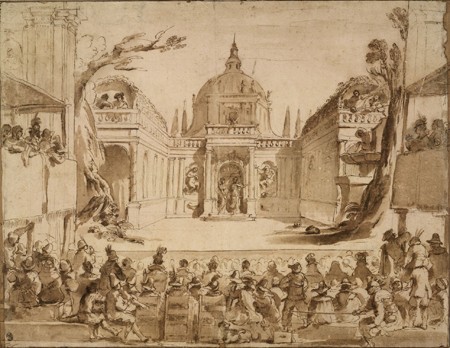Vasari’s Lives contains many references illustrating the relationship between the visual arts and the theater, indicating that Renaissance artists were frequently involved in the staging of plays, often as part of liturgical festivities. These examples also imply reciprocity of influence between theatrical performances and religious art in this period. The discovery of a play written for the Carmelite church of San Martino ai Monti in Rome that is an almost perfect fit with decorations commissioned in 1647 from Gaspar Dughet (1615–1675) suggests that this exchange between the visual and the performing arts continued well into the Seicento. The theatrical character of baroque art has become a truism, but the real exchange between the visual arts and dramatic performance is only rarely studied. Therefore, my research focuses on ways in which Seicento biographers such as Filippo Baldinucci (1624–1697) referred to crossover between these two artistic disciplines and on how it can be understood as an artistic phenomenon. On another level, this inquiry leads to the question of how early modern concepts of narrativity and the link between images and words developed around 1600 from a sequential reading of multiple images to the equation of a narrative with a single image.
The lives of artists in Baldinucci’s Notizie de’
This silence seems to have been the result of the ubiquity of such commissions; Baldinucci wrote in the life of Buontalenti, “If I wished to mention here all the stage machinery, floats, triumphal arches, and other noble inventions made by our Bernardo Buontalenti . . . for comedies, jousts and tournaments, farces, masquerades, ball games, banquets and feasts, decorations for funerals, and other sacred events, I would never arrive at the end.” Furthermore, the ephemeral nature of these events entailed a loss of the artistic material that formed the basis of Baldinucci’s biographies. Religious plays were mostly commissioned by confraternities and monastic communities, and this type of patronage further limited the survival of relevant material. Finally, the very recurrence of these events led to a scarcity of references to
The hybridization of theatrical genres in baroque Italy resulted in a plethora of terms denoting these plays:
Members' Research Report Archive
Seicento Religious Theater and the Visual Arts: Contemporary References in Art Treatises
Arnold Witte, Universiteit van Amsterdam
Ailsa Mellon Bruce Visiting Senior Fellow, June 3–July 31

Giovanni Francesco Barbieri, called Il Guercino, A Theatrical Performance in the Open Air, c. 1621. British Museum, London; © Trustees of the British Museum